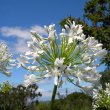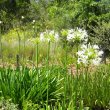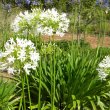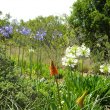| Botanical Name |
Agapanthus praecox subsp. praecox (white) |
| Family |
Amaryllidaceae - Subfamily Agapanthoidea - The agapanthus family. |
| Pronunciation |
|
| Common Name(s) |
English: White agapanthus
|
| Plant Group |
- Bulb / Corm / Rhizome / Tuber / Epigeal bulb Bulbs: are made up of fleshy scales as in an onion
Corm: a short, swollen, underground stem that is hard and not fleshy as in a gladiolus
Tuber: a solid, fleshy, underground, storage organ as in a potato
Rhizome: an underground, horizontal, swollen stem at the base of the plant as in an iris
Epigeal bulb: bulbs that rest above the ground with only the roots anchoring the plant to the earth as in albuca
- Ground Cover A plant with a low-growing, spreading habit, grown specifically to cover the ground.
|
| Plant Size |
- Large
| Tree | 18m to 25m |
| Shrub | 3m to 4m |
| Perennial/ground cover | 75cm to 1m |
| Bulb | 80cm to 1.2m |
| Succulent | 1m to 1.5m |
|
| Position |
- Canopy Shade Canopy shade is found below closely grown trees where some light filters through. Ideal for the protection of herbaceous plants.
- Light or Dappled Shade Found below trees with sparse, open foliage. Ideal for the protection of herbaceous plants.
- Partial Shade The area is in shade for part of the day and in full sun for part of the day.
- Sun The area is in full sun for all or most of the day, all year round.
|
| General Information |
- Drought Tolerance: High The plant is well adapted to arid conditions; it can survive long periods of drought and high temperatures without extra water.
- Evergreen Plants that have leaves all year round.
- Frost: Half-hardy The plant is able to survive low temperatures and some frost but requires protection against severe frost.
- Sand tolerant Plants adapted to survive in nutrient poor, very sandy soils.
- Water Moderate These plants will need some extra watering compared to water-wise plants. Plant them together, in at least some shade and in a convenient proximity to the house so that grey water can be utilised during times of drought.
- Wind Tolerant Plants able to withstand the effect of strong winds.
|
| Specific Information |
Agapanthus praecox has robust, strap-like, evergreen leaves with 6 - 20 leaves per individual plant. The leaves grow in dense clumps from bulb up to 60 cm high. , Although often considered a tired, old fashioned garden plant, I still find agapanthus a joy to the eye and a useful plant for backgrounds, borders and banks. Agapanthus praecox does well even in poor soils and thrives and survives despite our frequent periods of drought.
Usually pest and disease free, we had a spate of snout beetle damage to all our agapanthus species for a couple of seasons. Look out for wilting and yellowing of most of the leaves.
|
| Ad Break |
|
| Flowers |
| Description |
trumpet-shaped individual flowers in a large round head on a stem up to a meter tall
|
| Season |
- Summer Plants will seldom bloom for the entire season as given in the list, but should flower during a period within these parameters.
|
| Colour |
|
| Growth Rate |
- Moderate to Fast Specifying growth rate can be very misleading as there is considerable variation of growth rate depending on type and species of plant, available water, supplementary feeding, mulching and general care, as well as the plants suitability and adaptability to the garden environment.
|
| Plant Uses |
- Attracts bees, butterflies or other insects This plant attracts insects which can be food for birds or other creatures in your garden.
- Border A strip of ground, at the edge of a driveway or path in which ornamental plants or shrubs are planted.
- Container Trees, shrubs and ornamental species that can adapt to growing in a restricted environment.
- Cut Flowers Plants that provide flowers suitable for ornamental uses.
- Filler Either a fast growing tree or shrub used temporarily to fill in an area while the permanent plants grow to a desired size, or a plant used to fill gaps in borders or beds.
- Ground Cover Low-lying plants that spread fast, require minimal maintenance, and cover large expanses or bare areas between bulbs or shrubs. They provide protection from erosion and drought and improve the visual appearance of the garden.
- Mass Planting Plants useful for filling a large area with just one or a few kinds of plants spaced close together. Creates a bold, dramatic effect and to reduces maintenance.
- Pioneer for new gardens A very fast growing plant, able to withstand hardship, that can be used to populate land that has recently been cleared of natural vegetation. These plants pave the way for slower-growing species by adding nutrients to the soil and creating leaf litter.
- Rock Garden An area constructed of larger rocks, arranged naturally, to emphasise the use of stones as a main element. Generally plants used do not need a lot of care.
- Stabilize Banks Plant is used to prevent soil erosion because their roots will form a mat that stabilizes the soil and keeps it from washing away in heavy rains.
- Suitable for coastal gardens Plants adapted to dry, sandy soil, forceful wind, limited rainfall and intense sunlight.
- Suitable for seaside gardens Plants that will survive the hostile environment of harsh salty winds, dry sandy soil, irregular rainfall and heat found in seaside gardens.
- Water Features These plants may have dramatic, lush foliage or graceful form. They do not shed excessive leaves and do not have invasive root systems.
- Wild Garden An indigenous garden planted for the benefit of wildlife and birds. Provides food, water, a variety of mini-biomes and no poisonous chemicals are used.
|
| Distribution and Habitat |
in the Western Cape, Eastern Cape and KwaZulu-Natal, at forest edges, in open forest, coastlands, natural forests and adjacent to rivers and streams
|
| Planting Suggestions |
Lift and divide clumps every four years, in March, after flowering. Cut off half the foliage and two-thirds of the root. Replant immediately and water thoroughly. Agapanthus flower best in their first season after dividing. To perform well, agapanthus must receive some water in summer. Agapanthus will do well in even the poorest soils but for best results plant in well-drained soil with plenty of compost and mulch well. Water deeply once a week during spring and summer for a spectacular show of flowers.
|
| Medicinal Uses |
Traditionally, agapanthus is both a magical and a medicinal plant, and the plant of fertility and pregnancy. Xhosa women use the roots to make antenatal medicine, and roots are worn on a necklace as a charm to bring healthy, strong babies. It is combined with other plants to be taken during pregnancy to ensure healthy children, or to assist or induce labour. The Zulu use agapanthus to treat heart disease, paralysis, coughs, colds, chest pains and tightness. It is also used as a love charm and by people afraid of thunderstorms, and to ward off thunder. The leaves can be used to soothe weary feet, hold a dressing place, and wound around the wrists, are said to help bring a fever down.
|
| Ad Break |
|










Discuss this plant
Share knowledge, ask a question or give an experience.